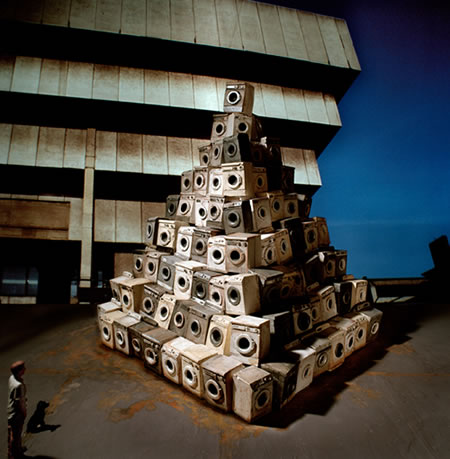Stadiums of disaster and war
A "tennis dome/emergency center" outside Kobe, Japan, gets a quick review in the new issue of Architectural Record.
 [Image: Shuhei Endo's "tennis dome/emergency center" (left), photographed by Kenichi Amano, next to the New Orleans Superdome, post-Katrina].
[Image: Shuhei Endo's "tennis dome/emergency center" (left), photographed by Kenichi Amano, next to the New Orleans Superdome, post-Katrina].
Designed by Shuhei Endo, the building is both a sports complex and a regional disaster preparedness center – it can become a field hospital, refugee camp, and even perhaps a prison in times of national emergency.
I'm reminded of that famous scene from J.G. Ballard's excellent novel Empire of the Sun, wherein the European prisoners of war are led into Shanghai's former Olympic Stadium:
And are sports infrastructure twinned with military-run refugee camps really the end-game of 21st century disaster urbanism?
 [Image: Stacked washing machines, from the J.G. Ballard-inspired series Future Ruins by Michelle Lord].
[Image: Stacked washing machines, from the J.G. Ballard-inspired series Future Ruins by Michelle Lord].
Of course, I'm also reminded of a scene toward the end of 28 Weeks Later, when the American military helicopter lands on the grass football pitch of Norman Foster's new Wembley Stadium: the grass, untended now for 28 weeks, is waist-high, like a wild English meadow, the stalks blowing in slow, flattening spirals from the crosswinds of the aircraft's blades.
How ironic to think that sports stadiums – justifiably bemoaned by certain urban planners for their financial short-sightedness – might someday prove to be the most valuable buildings in the city.
 [Image: Shuhei Endo's "tennis dome/emergency center" (left), photographed by Kenichi Amano, next to the New Orleans Superdome, post-Katrina].
[Image: Shuhei Endo's "tennis dome/emergency center" (left), photographed by Kenichi Amano, next to the New Orleans Superdome, post-Katrina].Designed by Shuhei Endo, the building is both a sports complex and a regional disaster preparedness center – it can become a field hospital, refugee camp, and even perhaps a prison in times of national emergency.
- In the event of an earthquake or typhoon, supply trucks can drive directly into the 174,000-square-foot building, thanks to movable glass panels at four locations around the perimeter. But on normal days, athletes enter primarily through a domed foyer on the building’s east side.
I'm reminded of that famous scene from J.G. Ballard's excellent novel Empire of the Sun, wherein the European prisoners of war are led into Shanghai's former Olympic Stadium:
- This concrete arena had been built on the orders of Madame Chiang Kaishek, in the hope that China might be host to the 1940 Olympic Games. Captured by the Japanese after their invasion in 1937, the stadium became the military headquarters for the war zone south of Shanghai.
- Bedsteads and wardrobes, refrigerators and air-conditioning units were stacked above one another, rising in a slope toward the sky. The immense presidential box, where Madame Chiang and the Generalissimo might once have saluted the world's athletes, was now crammed with roulette wheels, cocktail bars and a jumble of gilded plaster nymphs holding gaudy lamps above their heads.
And are sports infrastructure twinned with military-run refugee camps really the end-game of 21st century disaster urbanism?
 [Image: Stacked washing machines, from the J.G. Ballard-inspired series Future Ruins by Michelle Lord].
[Image: Stacked washing machines, from the J.G. Ballard-inspired series Future Ruins by Michelle Lord].Of course, I'm also reminded of a scene toward the end of 28 Weeks Later, when the American military helicopter lands on the grass football pitch of Norman Foster's new Wembley Stadium: the grass, untended now for 28 weeks, is waist-high, like a wild English meadow, the stalks blowing in slow, flattening spirals from the crosswinds of the aircraft's blades.
How ironic to think that sports stadiums – justifiably bemoaned by certain urban planners for their financial short-sightedness – might someday prove to be the most valuable buildings in the city.





Comments are moderated.
If it's not spam, it will appear here shortly!
However, I'm also thinking of the Winchester in Shaun of the Dead, the London pub to which the main characters flee after that city has been taken over by zombies.
I suppose, in times of disaster, we also just go where we feel most comfortable...
you should really be thinking of chile in 1973 when 'subversives' were rounded up and deposited in a soccer stadium....
I was about to say exactly that, Anon. There's a film about it, apparently, which I haven't seen...
See also the ExxonMobil Arena.
Thanks for the Chile link, Owen - I'd love to see that film. Nice new feature on Archinect, by the way.
And the ExxonMobil plan is amazing! I wish I had seen that earlier.
i also love to see that film owen..
also reminds me of shopping malls, a la Dawn of the Dead
that be Birmingham City Library
http://tinyurl.com/5agfoe
"Reading Foucault's history of the prison, Discipline and Punish (1979), I was struck by the great similarity between the transition of punishment on the one hand, and of sport on the other, each being transformed from activities undertaken in corporal/public space to those found in carceral/private space. ... Indeed, the stadium is regarded as such a secure form of containment that it is, intact, actually used as a prison in times of national security or repression" (Bale, 1994, p. 83).
Also, Giorgio Agamben's Means Without End: Notes on Politics might have something to offer here in a more theoretical rather than applied sense.
Post a Comment